

‘Those who have a strong sense of love and belonging have the courage to be imperfect’ Brene Brown. – Exploring Social Pedagogy: The Slightly Unknown! (436) Ladder of Inference. The Power of Collective Efficacy. Full article: Relationship-based practice and the creation of therapeutic change in long-term work: social work as a holding relationship. There is a remarkable absence of research literature that illuminates what social workers do by observing their practice as they are doing it and virtually none that has used participant observation to get close to long-term work with service users.
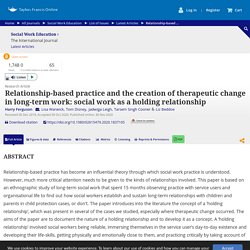
An Introduction to Social Pedagogy: featuring social work practitioners and academics/ authors. Chapter 4.1: The hermeneutic circle. O'Brien 5 accomplishments 2. Person Centred Planning Handout. ThemPra Social Pedagogy - ThemPra Social Pedagogy. ThemPra is a social (pedagogical) enterprise supporting the sustainable development of social pedagogy through a range of short courses, organisational capacity building and whole-systems strategies.
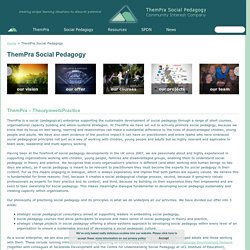
At ThemPra we have set out to actively promote social pedagogy, because we know that its focus on well-being, learning and relationships can make a substantial difference to the lives of disadvantaged children, young people and adults. Demand for Developmentally Informed Prevention Strategies. Learned Helplessness. Erik. 10 Lessons from 10 years on the Frontline: 6, Attachment and Trauma – Richard... By Richard Devine (07.09.2020), Social Worker for Bath and North East Somerset Council.
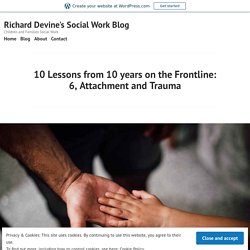
Originally I had intended to write a blog with 10 pithy lessons from my experience of being a social worker since I qualified in 2010. What I have done instead is write 10 lengthy (ish) lessons, each amounting to the equivalent of a blog. Therefore, given the length of each one, I am going to share one every working day for the next two weeks (hoping that I can finish the final two before next week!). The Diffusion of Innovations. Yesterday was my final presentation concerning outreach and evangelism in our postmodern world.
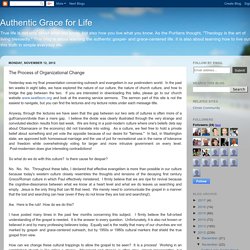
In the past ten weeks in eight talks, we have explored the nature of our culture, the nature of church culture, and how to bridge the gap between the two. If you are interested in downloading this talks, please go to our church website www.seattlecrc.org and look at the evening service sermons. The sermon part of this site is not the easiest to navigate, but you can find the lectures and my lecture notes under each message title.
Anyway, through the lectures we have seen that the gap between our two sets of cultures is often more of a gulf/canyon/divide than a mere gap. I believe the divide was clearly illustrated through the very strange and convoluted election results from last week. Informal Strengths Assessment: Simple Ways to Realise Strengths in People. Helping people realise their strengths enables you to get the best from them whatever the context.
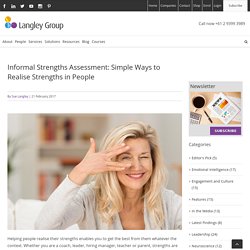
Whether you are a coach, leader, hiring manager, teacher or parent, strengths are natural, authentic resources that people can draw on to achieve higher performance, find more fulfilment and reach their potential. There are many ways to discover people’s strengths and bring strengths to life in workplaces, classrooms and coaching. In previous articles we outlined formal methods for identifying and developing strengths based on the research, and highlighted our favourite tool, Strengths Profile (formerly R2 Strengths Profiler). In this article I’ll introduce you to some of the informal strengths-identification methods you can use to complement formal assessment, provide flexible alternatives or introduce strengths more broadly and to wider audiences.
Strengthspotting Alex Linley explains that strengths energise and enable us to do our best. Induce Flow State with These 11 Activities and Exercises (+ 6 Examples) Systems theory is the interdisciplinary study of systems in general, with the goal of elucidating principles that can be applied to all types of systems at all nesting levels in all fields of research.
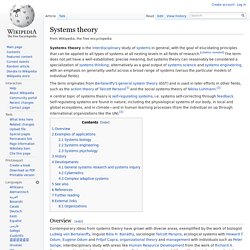
[citation needed] The term does not yet have a well-established, precise meaning, but systems theory can reasonably be considered a specialization of systems thinking; alternatively as a goal output of systems science and systems engineering, with an emphasis on generality useful across a broad range of systems (versus the particular models of individual fields). A central topic of systems theory is self-regulating systems, i.e. systems self-correcting through feedback. Self-regulating systems are found in nature, including the physiological systems of our body, in local and global ecosystems, and in climate—and in human learning processes (from the individual on up through international organizations like the UN).[3] Overview[edit] Key points Appreciative inquiry is an action research approach that offers a powerful contribution to meeting the appetite for real change that is evident across public services in Scotland.
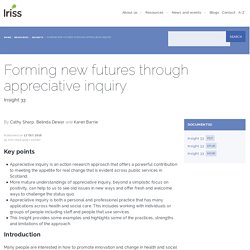
More mature understandings of appreciative inquiry, beyond a simplistic focus on positivity, can help to us to see old issues in new ways and offer fresh and welcome ways to challenge the status quo. Appreciative inquiry is both a personal and professional practice that has many applications across health and social care. This includes working with individuals or groups of people including staff and people that use services. Cognitive dissonance. Psychological stress resulting from multiple contradictory beliefs, ideas, or values held at the same time Coping with the nuances of contradictory ideas or experiences is mentally stressful.
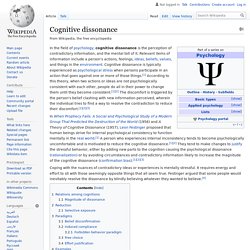
It requires energy and effort to sit with those seemingly opposite things that all seem true. Festinger argued that some people would inevitably resolve dissonance by blindly believing whatever they wanted to believe. Relations among cognitions[edit] To function in the reality of society, human beings continually adjust the correspondence of their mental attitudes and personal actions; such continual adjustments, between cognition and action, result in one of three relationships with reality:[2] One's self-perception is defined by one's self-concept, self-knowledge, self-esteem, and social self.
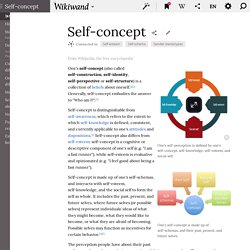
One's self-concept (also called self-construction, self-identity, self-perspective or self-structure) is a collection of beliefs about oneself.[1][2] Generally, self-concept embodies the answer to "Who am I? ".[3] I.
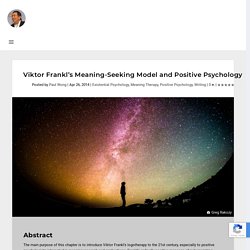
Introduction I. 1. The Socio-Political Milieu of Frankl’s Logotherapy I. 2. The Positive Bias of Positive Psychology I. 3. Positive Psychology Research on Meaning I. 4. The Positive Psychology of Meaningful Living I. 5. II. III. IV. V. Appendix. In recent years, there has been growing interest in meaning research. MENA-C4D-Report-May2019.pdf. 93607_Chapter_1__What_is_Heuristic_Inquiry_Anyway.
Social constructionism in social care. Connecting theory with social work in the Covid-19 pandemic (Webinar 3) Power and empowerment? The Theory and Practice. Social Work Student Connect W... SHAME The theory base: Too often ignored in social work? Social work student ... Kubler Ross change curve. Solve Communication Complexity With Networks Of Small Teams. Work is solving other people’s problems. Most progressive companies on our Bucket List think they do that best when structured as networks of teams, rather than hierarchical pyramids.
What is The Change Triangle, Hilary Jacobs Hendel. "The Change Triangle" is a map. A guide to carry you from a place of disconnection back to your true Self. It's a step-by-step process for simply feeling better. It works by getting you reacquainted with core emotions like joy, anger, sadness, fear, and excitement. A quick guide to attachment theory. Attachment theory was developed by John Bowlby, a British psychologist, partly as a result of the experience of hundreds of thousands of children during the second world war who were separated from their parents and evacuated to safer areas of the UK. His work on the importance of parent-infant bonds revolutionised childcare around the world. Attachment theory has moved on considerably since its early days: it is rare nowadays to focus solely on mothers and babies.
Although the ideas underpinning it connect with all aspects of social care, this article is intended primarily for social workers and others working with children and families. What’s there to say about attachment theory that’s not been said already? Let me suggest a few things. Marcia’s four identity statuses can be better represented in a table How memories form and how we lose them - Catharine Young. Memory: It isn’t just something, it's everything.
And although scientists have pursued and puzzled over it for centuries, a definitive explanation of the actual memory process still eludes us--partly because our brain is so incredibly complex (it is made up of approximately 90 billion cells after all!). Let’s take a look at the basic neuroanatomy elements, which makes memory possible. Brain cells, called neurons are the core component of the nervous system and have the remarkable ability to communicate with each other and transfer information. They are able to accomplish through a process called synaptic transmission. Neurons release specialized proteins called neurotransmitters that travel through the space connecting each other together called synapses, and bind to specific proteins called receptors. In order for new memory formation to occur, information needs to undergo certain processes. Erickson's Psychosocial Theory of Human Development. How Seligman's Learned Helplessness Theory Applies to Human Depression and Stress.
Top 40+ questions to ask before embarking on any change. Organizational change management checklist Change management: why, how, what, when, who Companies increasingly face competitive pressures related to rapid and continuous adaptation to a complex, dynamic and highly interconnected global environment. When embarking on a change journey – what questions to ask. The Critical Thinking Skills Cheatsheet [Infographic] The Questioning Toolkit - Revised. Fallacy List. Building Adult Capabilities to Improve Child Outcomes: A Theory of Change. What is the difference between a theory, model, method and approach in social... What is Positive Organizational Psychology? (Applied Positive Psychology Series) A quick guide to attachment theory. Bloom's Taxonomy of Learning Domains: The Cognitive Domain.
Bloom's Taxonomy was created in 1956 under the leadership of educational psychologist Dr Benjamin Bloom in order to promote higher forms of thinking in education, such as analyzing and evaluating concepts, processes, procedures, and principles, rather than just remembering facts (rote learning). It is most often used when designing educational, training, and learning processes. The Three Domains of Learning The committee identified three domains of educational activities or learning (Bloom, et al. 1956): Cognitive: mental skills (knowledge) Affective: growth in feelings or emotional areas (attitude or self) Psychomotor: manual or physical skills (skills) Since the work was produced by higher education, the words tend to be a little bigger than we normally use.
While the committee produced an elaborate compilation for the cognitive and affective domains, they omitted the psychomotor domain. Cognitive Domain Knowledge Comprehension Application Analysis Synthesis Evaluation. (22) What is Inquiry-Based Learning? Untitled. Transactional vs Transformational Relationships - Alignment Rockford.
Untitled. LinkingTheoriststotheEYLFOutcomes. 2009 - Child Development Theorists from Freud to Erikson to Spock and Beyond 1. Circle of Security. Circle of Security Animation. Anderson & Anderson's Change Model. Anderson & Anderson’s model of change provides a comprehensive coverage of the entire process of change and equally explains the whole process of change as a cyclical process (Anderson and Anderson, 2001, p. 13). This model briefly views change from three perspectives: Content: It analyzes the technical as well as the organizational factors which require change; People: This analyzes the subjective factors such as the mindset, changes in the behavioral patterns of people as well as the cultural changes; Process: This stage is related with the possible action plans or strategies that can be crafted and implemented for driving the change initaitive successfully across the organziation. All the three processes are integrated and interdependent on each other.
The model is illustrated through nine phases as demonstrated in the diagram below: Polyvagal Theory Dr Stephen Porges. A quick guide to attachment theory. What Is Restorative Practices? PTM Framework (January 2018)_0. Stress-busting Hackney model under threat from cherry picking councils. Place Standard. The Psychology of Self-Transformation. Carl Jung and the Psychology of the Man-Child. Recognising the five stages of anger. The CAF process - Children and young people. Defense Mechanisms. Halo Effect. An overview of the recognition primed decision making model. Self-Efficacy in Victims of Child Sexual Abuse - Applied Psychology OPUS. Why Maslow's Hierarchy Of Needs Matters. May and Finch Normalization Process Theory. Concepts and Theories of Social Structure. Lexi Rose, Just all about life: Practice Education- The importance of student... - Free Articles & Strategies.